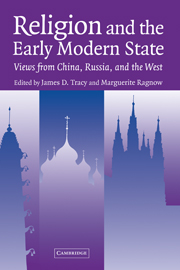Book contents
- Frontmatter
- Contents
- Contributors
- Acknowledgments
- Preface
- Religion and the Early Modern State
- Introduction
- PART I LIVED RELIGION AND OFFICIAL RELIGION
- 1 The Alternative Moral Universe of Religious Dissenters in Ming-Qing China
- 2 Ecclesiastical Elites and Popular Belief and Practice in Seventeenth-Century Russia
- 3 The State, the Churches, Sociability, and Folk Belief in the Seventeenth-Century Dutch Republic
- 4 Communal Ritual, Concealed Belief: Layers of Response to the Regulation of Ritual in Reformation England
- PART II FORMS OF RELIGIOUS IDENTITY
- PART III THE SOCIAL ARTICULATION OF BELIEF
- AN EPILOGUE AT THE PARISH LEVEL
- Selected Annotated Bibliography of Secondary Works
- Index
2 - Ecclesiastical Elites and Popular Belief and Practice in Seventeenth-Century Russia
Published online by Cambridge University Press: 23 May 2010
- Frontmatter
- Contents
- Contributors
- Acknowledgments
- Preface
- Religion and the Early Modern State
- Introduction
- PART I LIVED RELIGION AND OFFICIAL RELIGION
- 1 The Alternative Moral Universe of Religious Dissenters in Ming-Qing China
- 2 Ecclesiastical Elites and Popular Belief and Practice in Seventeenth-Century Russia
- 3 The State, the Churches, Sociability, and Folk Belief in the Seventeenth-Century Dutch Republic
- 4 Communal Ritual, Concealed Belief: Layers of Response to the Regulation of Ritual in Reformation England
- PART II FORMS OF RELIGIOUS IDENTITY
- PART III THE SOCIAL ARTICULATION OF BELIEF
- AN EPILOGUE AT THE PARISH LEVEL
- Selected Annotated Bibliography of Secondary Works
- Index
Summary
The Russian church schism of the seventeenth century is the focal point of this brief examination of popular belief and practice and the struggles of ecclesiastical elites to shape, control, and change them. The chapter will review and reflect on the most important phases of the interaction between the leaders of Russian Orthodoxy and ordinary parishioners between the late 1630s and the beginning of the eighteenth century in light of recent studies of Christian communities elsewhere in early modern Europe. It contains no new archival discoveries: Most of the documents and monographs on which it draws have long been familiar to historians of Russia. These sources, moreover, reflect the perceptions of government officials or ecclesiastical polemicists. Thus, as Eve Levin cautions, when describing popular religious beliefs and practices, they are likely to focus on “the most heterodox elements” that diverge most dramatically from established norms.
In spite of the country's enormous territory, the discussion will consider Russia as a single unit for two reasons. First, even a glance at scholarship on Western and Central Europe shows how limited and scattered are the surviving sources on Russian parish life and popular religious practice. For one thing, historians of Russia must live without systematic parish records. Second, in spite of the Muscovite monarchy's vast size, movements of popular religious protest spread quickly, in large measure through the efforts of itinerant agitators and exiles.
- Type
- Chapter
- Information
- Religion and the Early Modern StateViews from China, Russia, and the West, pp. 52 - 79Publisher: Cambridge University PressPrint publication year: 2004
- 1
- Cited by

